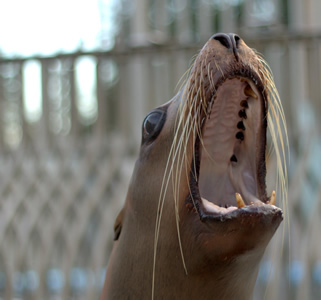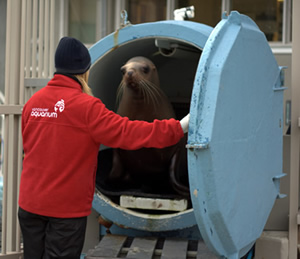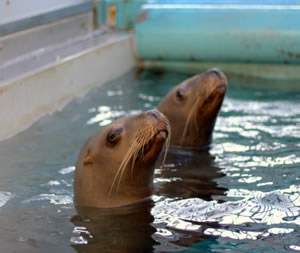
Scientific questions — like whether nutritional stress has led to the decline of Steller sea lion populations — are too large to be answered by a single experiment or study. Rather, scientists carefully examine one particular aspect of the overall hypothesis to test. Their individual results are added to the assemblage of scientific knowledge. However, at some point, these disparate chunks of understanding must be put together into a cohesive framework to readdress the validity of the original question.
In this way, answering a scientific question is a little like completing a jigsaw puzzle. Each experiment is akin to an individual piece, but the big picture can only be clearly seen when those pieces are put together in a logical fashion.
Consortium researcher Dr. David Rosen (UBC Marine Mammal Research Unit) recently undertook a comprehensive review of the evidence from studies of captive animals that could be used to evaluate the validity of the Nutritional Stress hypothesis as an explanation for the decline of Steller sea lions in the wild. His work was published in the journal Mammal Review. Put simply, the Nutritional Stress Hypothesis states that Steller sea lion populations in the North Pacific are in decline due to inadequate nutrition, caused by changes in the quality and quantity of their prey.
 Through the years, researchers have scrutinized the validity of the Nutritional Stress hypothesis using a variety of techniques, including controlled studies with seals and sea lions in the laboratory. Each of these studies has examined individual aspects of the hypothesis and used different techniques. Dr. Rosen’s review examines all of these divergent studies published to date that can be used to support or strike down the Nutritional Stress hypothesis, whether that was the original aim of the study or not. The task was made particularly difficult by the differences in study aims and techniques. In the end, however, a cohesive picture emerged of how nutritional stress might occur in the wild and how it would affect individual Steller sea lions.
Through the years, researchers have scrutinized the validity of the Nutritional Stress hypothesis using a variety of techniques, including controlled studies with seals and sea lions in the laboratory. Each of these studies has examined individual aspects of the hypothesis and used different techniques. Dr. Rosen’s review examines all of these divergent studies published to date that can be used to support or strike down the Nutritional Stress hypothesis, whether that was the original aim of the study or not. The task was made particularly difficult by the differences in study aims and techniques. In the end, however, a cohesive picture emerged of how nutritional stress might occur in the wild and how it would affect individual Steller sea lions.
The first conclusion was that all prey species are not created equal. Scientists had previously linked declining local populations with ‘low quality’ prey such as walleye pollock or Atka mackerel, but studies with captive sea lions confirmed that these nutritional differences were magnified when the fish were digested by animals.
Second, sea lions could in theory make up for the lack of quality food by simply eating more low-energy prey without negatively impacting their growth or body composition. But in reality, this is not always possible. Juvenile digestive systems, for example, cannot handle large quantities of low-quality prey required to fuel their high energy requirements.
When sea lions could not consume enough prey to meet their energy needs — either because of decreased quality or availability — low quality prey appeared to cause additional problems. For example, Steller sea lions become less capable of making seasonally-appropriate energy allocation decisions under the influence of large amounts of low-quality prey.
 However, the exact impacts of consuming sub-optimal amounts or types of prey depend on a host of factors, including season, prey quality, age, and duration of the nutritional stress. In short, while poor quality prey tend to have more negative effects on individual sea lions, the actual effects are complicated to predict.
However, the exact impacts of consuming sub-optimal amounts or types of prey depend on a host of factors, including season, prey quality, age, and duration of the nutritional stress. In short, while poor quality prey tend to have more negative effects on individual sea lions, the actual effects are complicated to predict.
While the review presented a consistent picture of the possible immediate causes and effects of nutritional stress, Dr. Rosen acknowledged that such laboratory studies have their limitations. They were not designed to identify the source of nutritional stress in declining Steller populations (e.g. climate change, fisheries competition, etc), but rather to pinpoint the conditions under which changes in sea lion prey cause nutritional stress, and the physiological impacts of these changes. This knowledge will ultimately enable researchers to piece together the bigger picture.
SEE RELATED PUBLICATION:
|

|

 |
||||||||||||
